Medical expert of the article
New publications
Preparations
Allergic rhinitis sprays
Last reviewed: 07.07.2025

All iLive content is medically reviewed or fact checked to ensure as much factual accuracy as possible.
We have strict sourcing guidelines and only link to reputable media sites, academic research institutions and, whenever possible, medically peer reviewed studies. Note that the numbers in parentheses ([1], [2], etc.) are clickable links to these studies.
If you feel that any of our content is inaccurate, out-of-date, or otherwise questionable, please select it and press Ctrl + Enter.
An effective means of local therapy of allergic sensitization of the body is a spray for allergic rhinitis. The use of this form of drugs allows to significantly reduce nasal discharge (rhinorrhea), reduce itching and sneezing, and also relieve swelling of the mucous membranes of the nose that causes chronic nasal obstruction (stuffiness) in seasonal allergies (hay fever) and during exacerbation of persistent (year-round) allergic rhinitis.
In addition, indications for the use of intranasal aerosol preparations include IgE-dependent vasomotor rhinitis and hay fever.
Names of sprays for allergic rhinitis
To restore the impaired permeability of the vascular walls, reduce the intensity of edema and serous inflammation of the mucous tissues of the nasal cavity and exudate secretions, the following sprays for allergic rhinitis are used:
- Hormonal sprays for allergic rhinitis containing glucocorticosteroids: Nasobek (Aldecin, Beclazone, Beconase, Benorin, Clenil, etc.); Nazarel (Flutinex, Flixonase); Amavis; Nasonex; Budesonide (Rinocort, Tafen nasal).
- Drugs that block peripheral H1 receptors (histamine receptors): Allergodil (Azelastine); Tizin-Allergy (Levoreact, Histimet, Reactin).
- Agents that stabilize mast cell membranes: Cromoghexal (Cromopharm, Cromoglin, Cromosol, Ifiral).
- Decongestant sprays (α-adrenergic agonists or sympathomimetics): Nazivin (Ximedin, Xylen, Nazol), Otrivin (Pharmazoline Noxprey), Lazolvan Rhino, Nazosprey, etc.
Otolaryngologists believe that H1-histamine blockers are safer, but corticosteroids are more effective in relieving inflammation. As for decongestants - decongestant sprays for allergic rhinitis, despite their unconditional effectiveness in combating nasal congestion, these products are not recommended for use for more than a week, since the nasal mucosa stops responding to them, and the runny nose, as a rule, gets worse.
Hormonal sprays for allergic rhinitis
The pharmacodynamics of aerosol agents of this group is the suppression of inflammation by synthetic analogues of adrenal cortex hormones: beclomethasone dipropionate (Nasobek, Aldecin, Beclazone, Beconase), fluticasone propionate (Nazarel, Flixonase), fluticasone furoate (Amavis), mometasone furoate (Nasonex) and budesonide (Budesonide, Rinocort).
When these substances enter the nasal mucosa, not only is the proliferation of mast cells and basophils suppressed in the tissues, but the release of allergy and inflammation mediators (leukotriene, cytokines, histamine, etc.) from eosinophilic granulocytes is also reduced. Chemotaxis, the movement of immunocompetent leukocyte cells to the site of inflammation, is also slowed down. As a result, swelling of the nasal mucosa and mucus production are reduced.
The pharmacokinetics of hormonal drugs for allergic rhinitis is described taking into account their insignificant systemic absorption by binding to plasma proteins (at the level of 0.1-1%). Thus, the active substances of the sprays Nasobek, Bekonase, Aldecin are absorbed by the nasal mucosa, and how much gets into the stomach and bloodstream is difficult to determine with precision. However, two-thirds of the metabolites of GCS are excreted from the body with feces and urine (the half-life ranges from 3 to 15 hours).
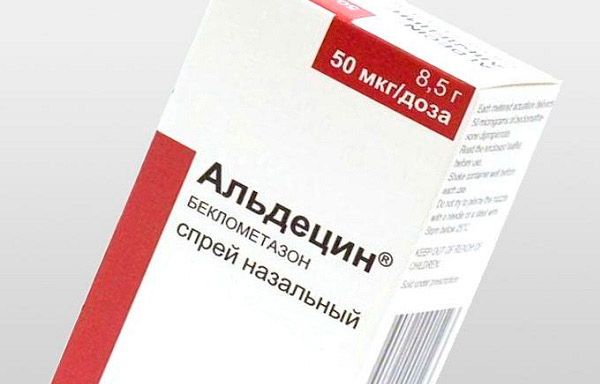
Contraindications to the use of sprays for allergic rhinitis based on GCS:
- hypersensitivity to the main or auxiliary substances of the drugs;
- pulmonary tuberculosis;
- viral (HSV) and fungal (Candida albicans) infections in the nasopharynx;
- children under 6 years of age (Nazarel – up to 4 years, Nasonex – up to 2 years).
When prescribing these drugs, one should take into account the patient's tendency to nosebleeds, damage to the nasal septum, the presence of glaucoma, thyroid disease, liver disease and cardiovascular pathologies.
The instructions for the drugs of this pharmacological group indicate that the use of sprays for allergic rhinitis during pregnancy (in the first trimester) is prohibited. Sprays Nazarel, Flixonase, Budesonide are contraindicated throughout pregnancy, and the use of Nasobek, Amavis and Nasonex is possible only in extreme cases and if the expected benefit to the mother's health is higher than the potential threat to the development of the fetus.
Side effects of corticosteroid sprays most often manifest as increased dryness in the nose and an unpleasant odor, irritation and itching of the mucous membrane, bleeding, headache, and damage to the integrity (perforation) of the nasal septum.
Method of application of sprays for allergic rhinitis based on GCS: one or two sprays into each nasal passage (i.e. 1-2 presses on the spray dispenser) – once a day (in case of exacerbation of allergic rhinitis – twice during the day).
Overdosing on any sprays containing adrenal cortex hormones is dangerous due to the development of symptoms of hypercorticism, which manifests itself in obesity of the face and upper body, increased appetite, stretch marks on the skin, excessive hair growth in women (above the upper lip and on the chin), headache, increased blood pressure, pain in the bones and their increased fragility, sleep disturbances and depression.
Established interactions with other drugs exclude the simultaneous use of these antiallergic agents with systemic corticosteroids, anti-tuberculosis antibiotics, barbiturates, estrogens, hydantoin antiepileptic drugs and ephedrine preparations.
Storage conditions: at t=15-25°С; shelf life of Nazarel, Flixonase, Amavis
Nasonex, Budesonide – 3 years, Nasobek – 4 years.
H1 receptor blocker sprays
The therapeutic effect of Allergodil (Azelastine) and Tizin-Allergy (Levoreact) sprays is based on their active substances – azelastine hydrochloride and levocabastine, which bind to peripheral receptors of histamine H1 – a key tissue hormone responsible for the development of allergic reactions in the body. As a result, the release of histamine from mast cells and basophils is inhibited.
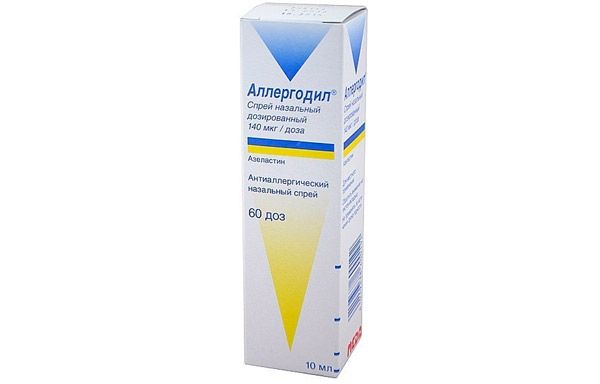
Allergodil penetrates into the blood and binds to plasma proteins by 93%, bioavailability of azelastine is 40%; metabolites after biotransformation in the liver are excreted in the urine (half-life is approximately 20 hours).
Levocabastine is absorbed into the blood in minimal amounts (less than 40 mcg after a single dose); the drug is excreted unchanged through the kidneys with a half-life of about 36-37 hours.
Contraindications to the use of these intranasal agents include intolerance to the substances included in the preparations, as well as age under 6 years. The use of Allergodil and Tizin-Allergy sprays during pregnancy is contraindicated.
Their main side effects are: headache, dizziness, nausea, irritation of the nasal mucosa, burning and itching in the nasopharynx, nosebleeds, skin rashes.
Method of application of intranasal sprays: Allergodil – 1-2 sprays in both nostrils maximum twice a day; Tizin-Allergy has the same dosage, but it can be used up to 4 times a day (in case of absolute obstruction of the nasal passages).
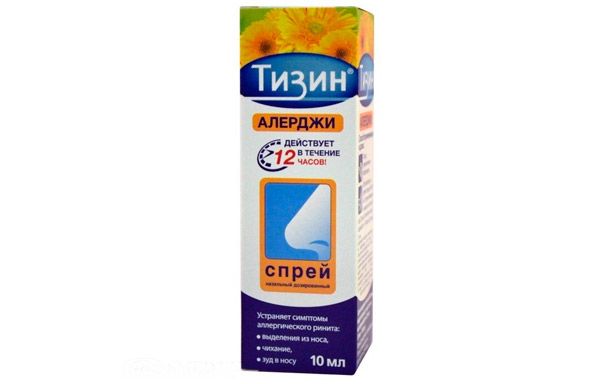
Overdose of these drugs can cause dizziness, a drop in blood pressure, and increased drowsiness.
Allergodil (Azelastine) and Tizin-Allergy (Levoreact, Gistimet, Reactin) sprays should be stored at room temperature; their shelf life is 36 months.
Allergic rhinitis spray with cromoglycic acid
The antiallergic effect of nasal sprays containing cromoglycic acid in the form of sodium cromoglycate - Cromogeksal, Kromofarm, Cromoglin, Cromosol, Ifiral - is based on the ability to stabilize the cytoplasmic membranes of mast cells, which in the process of the occurrence of an IgE-mediated allergic reaction are activated and undergo degranulation with subsequent release of inflammatory mediators from cellular structures, in particular, histamine H1. Sodium cromoglycate prevents this process by blocking the entry of Ca 2+ into the cell cytosol and inhibiting enzymes necessary for the release and chemotaxis of eosinophils, neutrophils, etc.
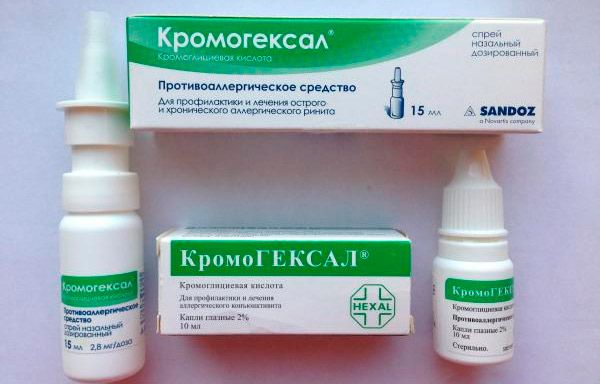
Pharmacokinetics: after Cromohexal (or synonymous drugs) gets on the mucous membrane of the nasal passages, it acts for 4-5 hours; about 6-7% of cromoglycate is absorbed into the tissue and enters the blood, which is not subject to biotransformation and is eliminated by the kidneys within 24 hours.
Contraindications to the use of cromoglycic acid preparations are hypersensitivity, as well as age under 6 years and pregnancy (first three months). The most likely side effects include irritation of the mucous membrane, skin rashes and nausea.
It is recommended to use Cromoghexal up to 4 times a day - one injection into each nasal passage. Cases of overdose have not been described.
Storage conditions: at a temperature not exceeding +25°C; shelf life – three years.
Decongestant sprays for allergic rhinitis
The vasoconstrictive mechanism of action of sprays Nazivin (Ximedin, Xylen, Nazol), Otrivin (Pharmazoline, Noxprey) is due to imidazole derivatives - oxymetazoline hydrochloride and xylometazoline, the chemical formulas of which differ only in the presence of an oxygen atom (in oxymetazoline). Having a structural similarity with the endogenous α-amino acid histidine (converted into histamine), these substances affect the α1-adrenoreceptors of the capillary walls, which leads to their narrowing, increased impermeability and decreased blood flow. Due to this, tissue swelling in the nose subsides and the secretion of mucous exudate is reduced.
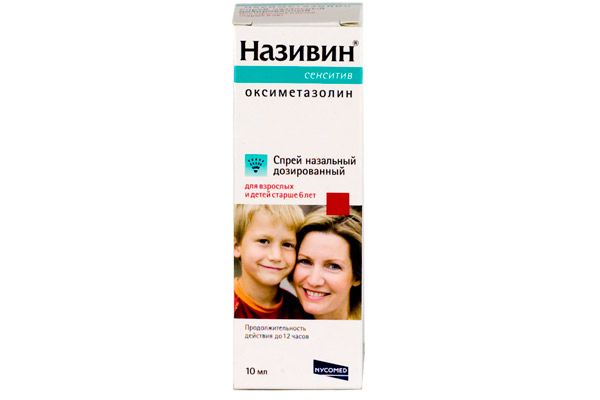
Pharmacokinetics of α-adrenomimetics Nazivin and Otrivin: the instructions note that the active substances of these sprays enter the systemic bloodstream in small quantities that do not have a systemic effect on the body. Imidazole derivatives act within 10-15 minutes after spray injection, and this effect lasts more than 10 hours after use.
Contraindications to the use of Nazivin, Otrivin and all their synonyms: atrophic rhinitis, glaucoma (closed-angle form), severe atherosclerosis and hypertension, tachycardia, thyrotoxicosis, history of brain surgery, age under six years.
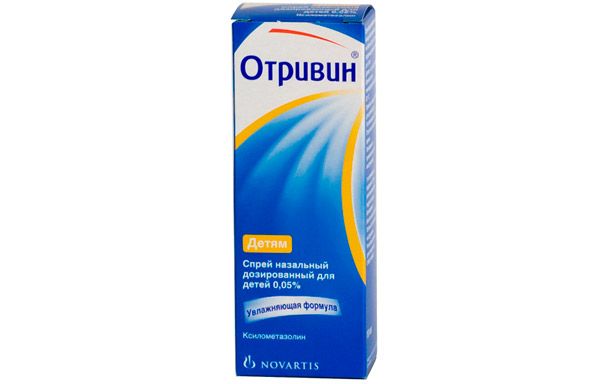
During pregnancy, the use of sprays for allergic rhinitis containing oxymetazoline hydrochloride or xylometazoline is contraindicated.
Side effects of these medications include: irritation of the nasal mucosa and its dryness; burning in the nose; loss of sensitivity and atrophy of the mucosa; swelling, sneezing, increased secretion; as well as headache, high blood pressure, irregular heartbeat, excessive mental excitability or depression.
Spray for allergic rhinitis Nazivin and Otrivin is recommended to be used no more than 2-3 times a day - one spray in each nostril. According to the instructions, the maximum duration of treatment should not exceed seven days in a row.
It should be borne in mind that an overdose of these drugs can lead to respiratory failure, pulmonary edema, coma and cardiac arrest.
Nazivin and Otrivin are incompatible with any intranasal agents, as well as with all systemic antipsychotic drugs.
Storage conditions for these products: at room temperature; shelf life - three years.
Attention!
To simplify the perception of information, this instruction for use of the drug "Allergic rhinitis sprays" translated and presented in a special form on the basis of the official instructions for medical use of the drug. Before use read the annotation that came directly to medicines.
Description provided for informational purposes and is not a guide to self-healing. The need for this drug, the purpose of the treatment regimen, methods and dose of the drug is determined solely by the attending physician. Self-medication is dangerous for your health.


 [
[